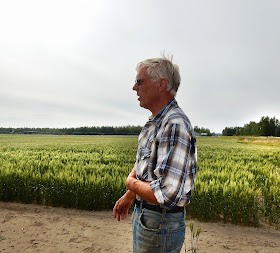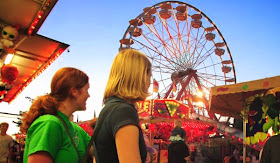Wheat flowering, Ben VanderWeele's farm, July 21, 2015.
bread in hand
farmer resting from sowing
wheat for next year’s loaf
Knik Valley wheat fields – they are
harvested by farmers from the Midwest, from the Netherlands, from temperate
climates, who brought their seeds to plant in the subarctic shadow of Pioneer
Peak. The Denaina Athabascan/Ahtna Indians who came a thousand years ago after
the Yupik/Chupik people called the area Benteh (many lakes). They fished
and hunted around Eklutna, Niteh, and their other villages for
eight hundred years before the Russian Orthodox missionaries came looking for
souls in 1840, and the American and European adventurers came seeking gold
thirty years later. The Indians knew nothing of grains or bread until the
Russians brought them Holy Communion and the Sourdoughs brought them fry-bread.
The soil into which the Knik Valley
wheat sinks its shallow roots is eolian – wind-blown, loess – dust particles
from the rocks ground away by the glaciers. Two hundred and fifty million years
ago the Mesozoic Era began, bringing dinosaurs, ferns, forests, the grassy
ancestors of wheat, and the first mammals. Pangaea was breaking up. Late in the
Mesozoic the tectonic plates were carrying the continents to their present
places on the earth, pushing ocean floors up against the continental plates to
build the Rockies, the Himalayas, the Alaska Range, and the Chugach mountains
that frame the Knik River Valley. The earth is still restless today, pushing
the mountains higher and reshaping the valleys.
In those hundreds of millions of
years, seas rose and fell, covering much of North America. The sea creatures
died, settled into the dirt and detritus that collected underwater, and slowly
packed together into rocks. When the ocean floor began crunching against the
continental plates, the beds of bodies and sediments pushed up and shaped the
mountains, mixed in with rocks spewed out from the hearts of volcanoes. In
science-speak, “The Mesozoic lithologies, primarily marine sediments and
volcanics, have been intensely metamorphosed, folded, and faulted and have been
intruded by small to moderate-size igneous [rocks from the volcanoes] bodies.”
Then the glaciers arrived, covering
and uncovering, and re-covering the river valleys, wearing the rocks into soils made of silt and sand. Shallow-rooted white spruce, large cottonwood trees, and
balsam poplar forested the flat lands in the river valleys, with shrubs,
wildflowers, and grasses on the slopes. The farmers who came in the early 1900s
stripped the land of its trees, and sowed wheat into long straight rows
stretching from their roads to the feet of the mountains.
Ben VanderWeele's wheat, August 2, 2015, Knik Valley with Chugach Mountains in the distance.
Today winds blow off the Knik and
Matanuska glaciers, lifting the soil made of ancient ocean lives from the bare
fields in late winter and laying it down on forests to the south and west. The
farmers must fertilize what’s left, and irrigate in the spring and summer to
make up for the sparse rain. Sixteen inches in a good year, it falls in August
and September when the grain should be drying for harvest. Even the nineteen
hours of sunlight in June and July doesn’t warm the air enough to make up for the cooling winds
off the glaciers and the nearby ocean. It’s not ideal for wheat, but the
stubborn farmers grow it nonetheless.
BenVanderWeele's wheat -- the rows in the middle ground (wild grasses in the foreground). Snow on the Chugach Range. September 5, 2015.
heavy brown wheat heads
too wet to harvest this week
snow on the Chugach
today’s Communion
wheat rows in slanting light
of September dusk
Ben VanderWeele in his wheat fields, July 21, 2015.
Ben VanderWeele photos by TW Carns.
































